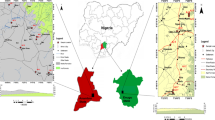Abstract
Scour and erosion potential of a soil are closely related to each other. Similarities or differences between them have not been defined fully and the terms are often used interchangeably or in association with one another. Erodibility is a property of soil that describes erosion potential. Therefore, a proper understanding of erodibility should help predict scour more accurately. In the past, researchers have looked into erosion of soils with the ultimate objective of understanding the erodibility with respect to the standard geotechnical properties. Most research has shown the difficulties associated with correlating erodibility to any one or more soil properties. The research described in this paper is mainly focused on the relationship between erodibility and dry unit weight of soil with varying fractions of fines. Soils tested using laboratory Jet Erosion Test (JET) indicated that the logarithm of erodibility makes a linear inverse relationship with the dry unit weight. In situ JETs confirmed the range of erodibilities established by the laboratory JETs. The best correlations between erodibility and dry unit weight appeared within a single category of soil as classified by the Unified Soil Classification System. In addition, it was also determined that the logarithm of erodibility is inversely related to the angle of internal friction of the fluvial soils tested during this investigation.











Similar content being viewed by others
References
Allen PM, Arnold J, Jakubowski E (1999) Prediction of stream channel erosion potential. Environ Eng Geosci 5(3):339–351
ASTM (2008) Annual book of standards. American Society of Testing and Materials, West Conshohocken
Briaud J-L, Govindasamy AV, Kim D, Gardoni P, Olivera F, Chen H-C, Mathewson CC, Elsbury K (2009) Simplified method for estimating scour at bridges. Report no. 0-5505-1, Texas Transportation Institute, College Station, TX, p 482
Das BM (2002) Principles of geotechnical engineering. Brooks/Cole, Pacific Grove
Govindasamy AV (2009) Simplified method for estimating future scour depth at existing bridges. Unpublished doctoral dissertation, Texas A&M University, College Station, TX
Hanson GJ (1992) Erosion resistance of compacted soils. Transportation Research Board, Transportation research record no. 1396
Hanson GJ, Cook KR (2004) Apparatus, test procedures, and analytical methods to measure soil erodibility in situ. Am Soc Agric Eng 20(4):455–462
Hanson GJ, Hunt SL (2007) Lessons learned using laboratory JET method to measure soil erodibility of compacted soils. Am Soc Agric Biol Eng 23(3):305–312
Hanson GJ, Simon A (2001) Erodibility of cohesive streambeds in the loess area of the midwestern USA. USDA, pp 23–28
Hanson GJ, Robinson KM, Cook KR (2002a) Scour below an overfall: Part II. Prediction. Trans ASAE 45(4):957–964
Hanson GJ, Simon A, Cook K (2002b) Non-vertical jet testing of cohesive streambank materials. In: 2002 ASAE annual international meeting/CIGR XVth world congress, Chicago, p 16
Paaswell RE (1973) Cause and mechanisms of cohesive soil erosion: the state of the art, pp 52–74
Richardson EV, Davis SR (2001) Evaluating scour at bridges. FHWA, p 378
Thoman RW, Niezgoda SL (2008) Determining erodibility, critical shear stress, and allowable discharge estimates for cohesive channels: case study in the Powder River Basin of Wyoming. J Hydraul Eng 134(12):1677–1687
Wardhana K, Haipriono F (2003) Analysis of recent bridge failures in the United States. J Perform Constr Facil 17(3):144–150
Wells R, Langendoen E, Simon A (2004) Numerical simulation of sediment loads and channel changes along the Kalamazoo River between plainwell and Otsego City, Michigan. USDA-ARS
Acknowledgments
Authors wish to thank the Michigan Department of Transportation (Research contract #2007-0436) and College of Engineering at Lawrence Technological University for making funds available for this project. We would also like to thank Tim Calappi for support with field work and data analysis.
Author information
Authors and Affiliations
Corresponding authors
Rights and permissions
About this article
Cite this article
McClerren, M.A., Hettiarachchi, H. & Carpenter, D.D. An Investigation on Erodibility and Geotechnical Characteristics of Fine Grained Fluvial Soils from Lower Michigan. Geotech Geol Eng 30, 881–892 (2012). https://doi.org/10.1007/s10706-012-9507-4
Received:
Accepted:
Published:
Issue Date:
DOI: https://doi.org/10.1007/s10706-012-9507-4




